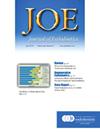Association between Apical Periodontitis and Autoimmune Diseases: A Systematic Review with Meta-analysis
IF 3.5
2区 医学
Q1 DENTISTRY, ORAL SURGERY & MEDICINE
引用次数: 0
Abstract
Objectives
The aim of this study was to perform a qualitative and quantitative synthesis of the available studies evaluating the possible relationship between apical periodontitis and autoimmune diseases.
Methods
The literature search was conducted across 6 electronic databases (PubMed/MEDLINE, Embase, SciELO, Web of Science, Cochrane Library, and Scopus). The search covered articles published up to September 2023. There was no disagreement between the 2 reviewers. The RevMan software (V5.3) (Copenhagen: The Nordic Cochrane Centre, The Cochrane Collaboration, 2014) was used for the meta-analysis. A dichotomized analysis was performed using the Mantel–Haenszel statistical method with a fixed-effect model and the risk ratio as the effect measure. A 95% confidence interval was adopted, and the significance level was set at P < .05. The presence of apical periodontitis was predefined as the event, with the experimental group consisting of patients with autoimmune disease and the control group consisting of patients without autoimmune disease (healthy individuals). The data used included the number of individuals presenting the event vs the total number of study participants.
Results
Nine studies were included and considered eligible. The methodological quality of the studies was classified as moderate in 5 of the 9 included studies, while 2 were rated as low, and 2 were rated as high-quality. The relative risk was 1.24 with a 95% confidence interval (1.08–1.62), in which the prevalence of apical periodontitis in comparing patients with autoimmune diseases and healthy patients yielded statistically significant results (P < .0001). Thus, patients with autoimmune diseases had a 24% higher relative risk of developing apical periodontitis compared to the healthy/control group.
Conclusions
The analysis of the studies included in this review suggests a potential association between apical periodontitis and autoimmune diseases. However, it is important to consider that the selected studies have limitations, primarily because they are observational studies.
根尖牙周炎与自身免疫性疾病之间的关系:一项meta分析的系统综述。
目的:本研究的目的是对现有的研究进行定性和定量的综合,评估根尖牙周炎与自身免疫性疾病之间可能的关系。方法:采用PubMed/MEDLINE、Embase、SciELO、Web of Science、Cochrane Library和Scopus 6个电子数据库进行文献检索。搜索涵盖了截至2023年9月发表的文章。两位审稿人之间没有分歧。采用RevMan软件(V5.3)进行meta分析。采用固定效应模型,以风险比为效应测度,采用Mantel-Haenszel统计方法进行二分类分析。采用95%置信区间,显著性水平p < 0.05。根尖牙周炎的存在被预先定义为事件,实验组由自身免疫性疾病患者组成,对照组由无自身免疫性疾病患者(健康个体)组成。使用的数据包括出席事件的个人人数与研究参与者的总人数。结果:纳入了9项符合条件的研究。纳入的9项研究中,有5项研究的方法学质量为中等,2项为低质量,2项为高质量。相对危险度为1.24,95%可信区间(1.08 ~ 1.62),其中自身免疫性疾病患者与健康患者的根尖牙周炎患病率比较具有统计学意义(p < 0.0001)。因此,与健康/对照组相比,患有自身免疫性疾病的患者发生根尖牙周炎的相对风险高出24%。结论:本综述中纳入的研究分析提示根尖牙周炎与自身免疫性疾病之间存在潜在关联。然而,重要的是要考虑到所选择的研究有局限性,主要是因为它们是观察性研究。
本文章由计算机程序翻译,如有差异,请以英文原文为准。
求助全文
约1分钟内获得全文
求助全文
来源期刊

Journal of endodontics
医学-牙科与口腔外科
CiteScore
8.80
自引率
9.50%
发文量
224
审稿时长
42 days
期刊介绍:
The Journal of Endodontics, the official journal of the American Association of Endodontists, publishes scientific articles, case reports and comparison studies evaluating materials and methods of pulp conservation and endodontic treatment. Endodontists and general dentists can learn about new concepts in root canal treatment and the latest advances in techniques and instrumentation in the one journal that helps them keep pace with rapid changes in this field.
 求助内容:
求助内容: 应助结果提醒方式:
应助结果提醒方式:


